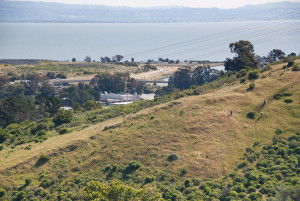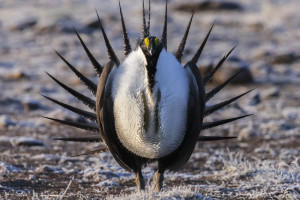At the northern edge of San Pablo Bay, a salt marsh harvest mouse hides beneath the protective cover of a pickleweed plant while a red-tailed hawk searches for breakfast. Only about six inches from the tip of its tail to its nose, the mouse, endemic to the salt marshes of the San Francisco Bay, clings to a precarious existence, facing not only raptors soaring above, but also a severe reduction of habitat. With 80 to 90 percent of the Bay’s historic tidal marshes altered for development, agriculture, or salt production, the harvest mouse has been listed as endangered with both state and federal agencies. But things are looking up for the harvest mouse, one of the smallest rodents in the United States.
In the October-December 2004 issue, Bay Nature reported on restoration plans for the former Cargill salt ponds in the North and South Bays. While the 15,100-acre South Bay restoration project is still in the planning and public comment phase (see below), restoration work on 4,680 acres in the North Bay will begin this fall in the Napa Sonoma Marshes Wildlife Area, a wetland owned and managed by the state Department of Fish and Game. The restoration site consists of eight former salt ponds located north of Mare Island and west of the Napa River and covers 10,000 acres. For now, Ducks Unlimited is tackling five of the ponds with state funds. The U.S. Army Corps of Engineers will begin restoration of the three remaining ponds once funding is secured.
According to Greg Green of Ducks Unlimited, the work on the first five ponds will cater to as many species as possible by including both tidal marsh and shallow and deep pools. The three ponds adjacent to the Napa River will be returned to natural tidal marsh by breaching levees. As native marsh vegetation returns, it will provide habitat for shorebirds and endangered species such as the California clapper rail, the black rail, and the salt marsh harvest mouse. At the other ponds, water levels will be regulated to accommodate migrant shorebirds in the shallow pond, and diving ducks in the deepest pond.
“The overall restoration will improve habitats for resident and migratory birds, as well as provide a nursery ground for Delta smelt, Sacramento splittail, steelhead trout, and chinook salmon,” says Green.
This first phase of the project, which should be completed by December 2006, will include three kayak-launching ramps. While the entire Napa Sonoma Marshes Wildlife Area is open to the public for hiking, bird-watching, boating, hunting, and fishing, most of it is accessible only by boat. Contact the Department of Fish and Game at (707)944-5500 for information.
When combined, the 10,000 acres in the North Bay and 15,000 acres in the South Bay will be the largest restoration project on the West Coast. In the South Bay this fall, the public can weigh in on long-term restoration planning at two Stakeholder Forum meetings, scheduled for October 14 and December 14. For details and directions, go to www.southbayrestoration.org.

.jpg)



